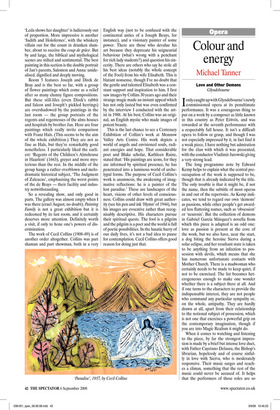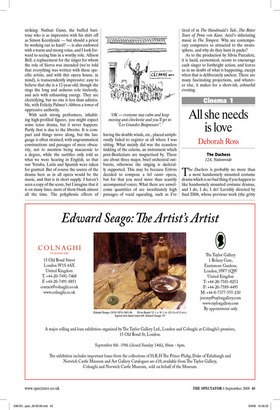Colour and
energy
Michael Tanner
Love and Other Demons Glyndebourne
Ionly caught up with Glyndebourne’s newly commissioned opera at its penultimate performance. It was a courageous thing to put on a work by a composer as little known in this country as Peter Eötvös, and was rewarded at the seventh performance with a respectably full house. It isn’t a difficult opera to follow or grasp, and though I was not especially impressed by it, in fact find it a weak piece, I have nothing but admiration for the élan with which it was presented, with the conductor Vladimir Jurowski giving a very strong lead.
The long programme note by Edward Kemp helps to explain what the central preoccupation of the work is supposed to be, though that is already indicated by the title. The only trouble is that it might be, if not the name, then the subtitle of most operas in and out of the repertoire. As Kemp indicates, we tend to regard our own ‘demons’ as passions, while other people’s get awarded less flattering names, such as ‘obsession’ or ‘neurosis’. But the collection of demons in Gabriel García Márquez’s novella from which this piece is adapted is an odd one: love as passion is present at the core of the work, but we also have, near the start, a dog biting the heroine Sierva during a solar eclipse, and her resultant state is taken to be anything from an infection to possession with devils, which means that she has numerous unfortunate contacts with Mother Church. There is a madwoman who certainly needs to be made to keep quiet, if not to be exorcised. The list becomes heterogeneous enough to make one wonder whether there is a subject there at all. And if one turns to the characters to provide the indispensable interest, they are not people who command any particular sympathy or, on the whole, antipathy. They are hardly drawn at all, apart from their relationship to the notional subject of possession, which is not one that exercises a powerful grip on the contemporary imagination, though if you are into Magic Realism it might do.
When it comes to watching and listening to the piece, by far the strongest impression is made by a brief but intense love duet, with Father Cayetano Delaura, the Bishop’s librarian, hopelessly and of course sinfully in love with Sierva, who is moderately responsive. Their music surges and reaches a climax, something that the rest of the music could never be accused of. It helps that the performers of these roles are so striking: Nathan Gunn, the buffed baritone who is as impressive with his shirt off as Simon Keenlyside — but should a priest be working out so hard? — is also endowed with a warm and strong voice, and I look forward to seeing him in a worthy role. Allison Bell, a replacement for the singer for whom the role of Sierva was intended (we’re told that everything was written with these specific artists, and with this opera house, in mind), is transcendently impressive: easy to believe that she is a 12-year-old, though she sings the long and arduous role tirelessly, and acts with exhausting energy. They are electrifying, but no one is less than admirable, with Felicity Palmer’s Abbess a tower of oppressive authority.
With such strong performers, inhabiting high-profiled figures, you might expect some tense drama, but it never happens. Partly that is due to the libretto. It is compact and things move along, but the language is often strained, with ungrammatical constructions and passages of mere obscurity, not to mention being macaronic to a degree, while the surtitles only told us what we were hearing in English, so that our Yoruba, Latin and Spanish were taken for granted. But of course the source of the drama here as in all opera would be the music, and that is in short supply. I haven’t seen a copy of the score, but I imagine that it is on many lines, most of them blank almost all the time. The polyphonic effects of having the double winds, etc., placed antiphonally failed to register at all where I was sitting. What mainly did was the ceaseless tinkling of the celesta, an instrument which post-Boulezians are magnetised by. There are about three major, brief orchestral outbursts, otherwise the singing is skeletally supported. This may be because Eötvös decided to compose a bel canto opera, but for that you need more than scantily accompanied voices. What there are unwelcome quantities of are inordinately high passages of vocal squealing, such as I’ve tired of in The Handmaid’s Tale, The Bitter Tears of Petra von Kant, Ariel’s infuriating music in The Tempest. Why are contemporary composers so attracted to the stratosphere, and why do they hunt in packs?
As to the production by Silviu Purcalete, it is lucid, economical, seems to encourage each singer to forthright action, and leaves us in no doubt of what is happening, except when that is deliberately unclear. There are many fascinating projections, and whatever else, it makes for a short-ish, colourful evening.



































































 Previous page
Previous page